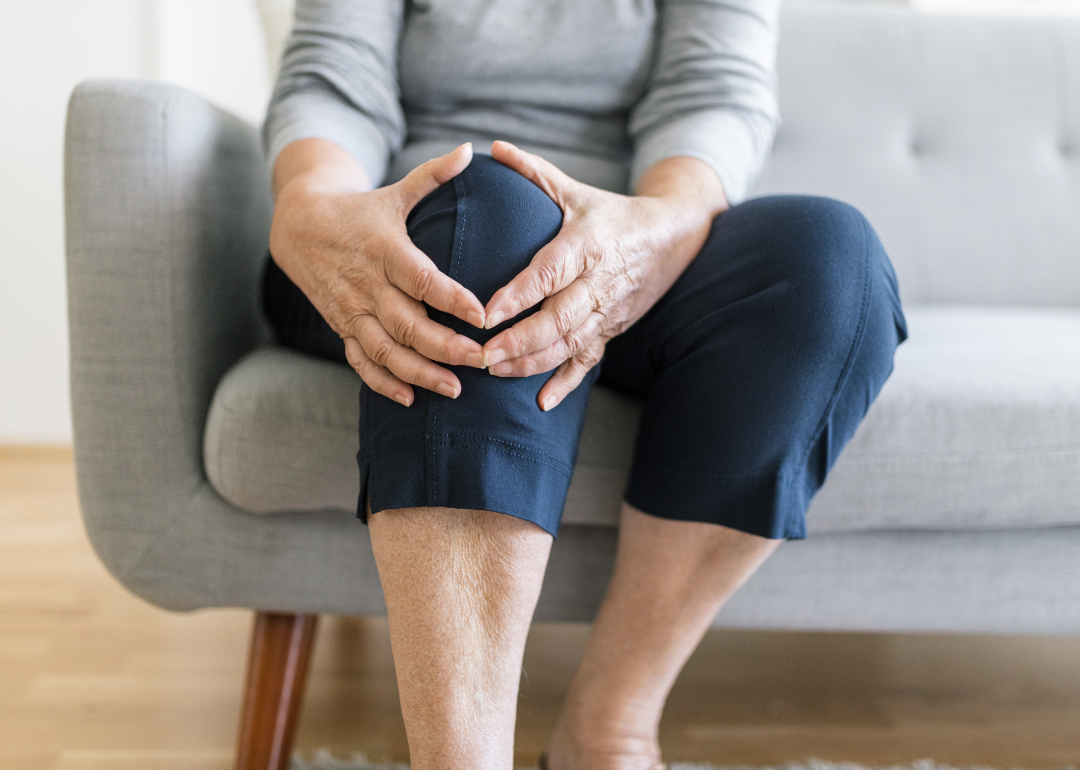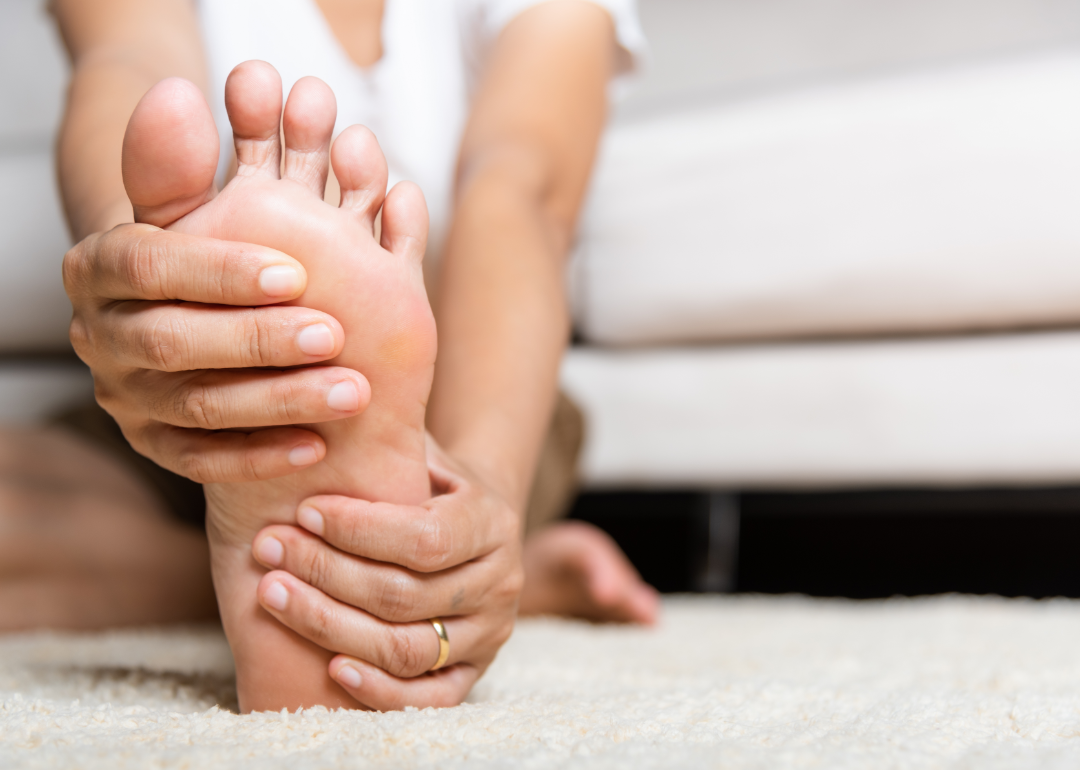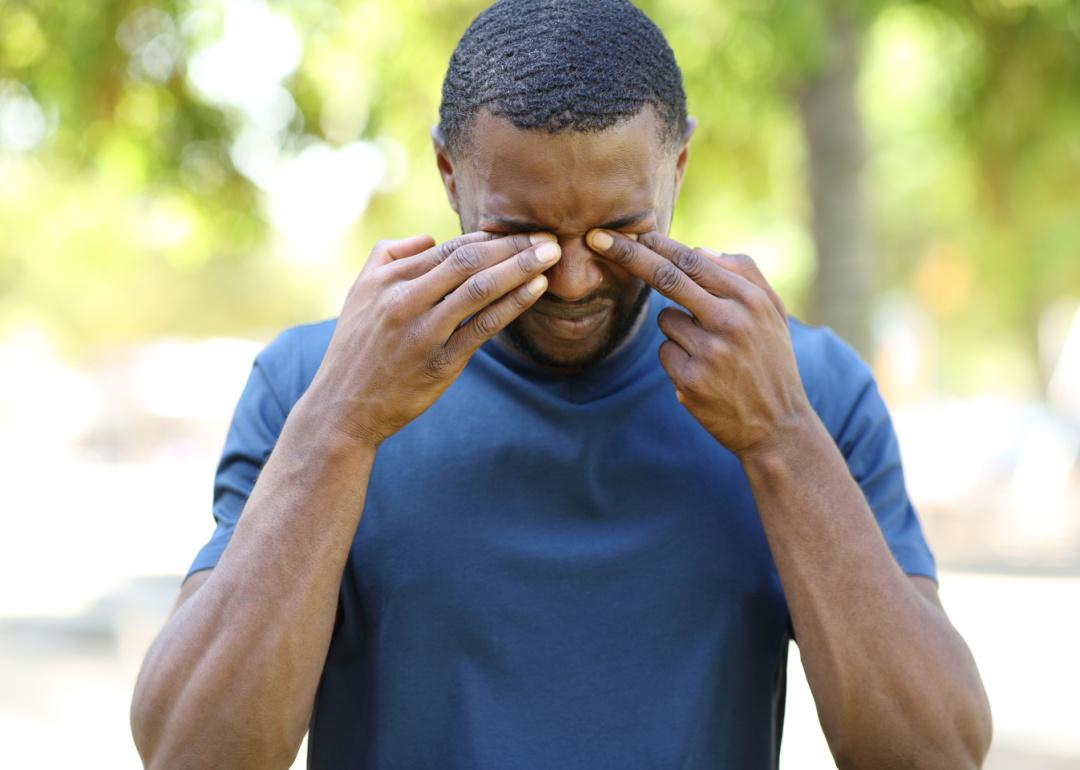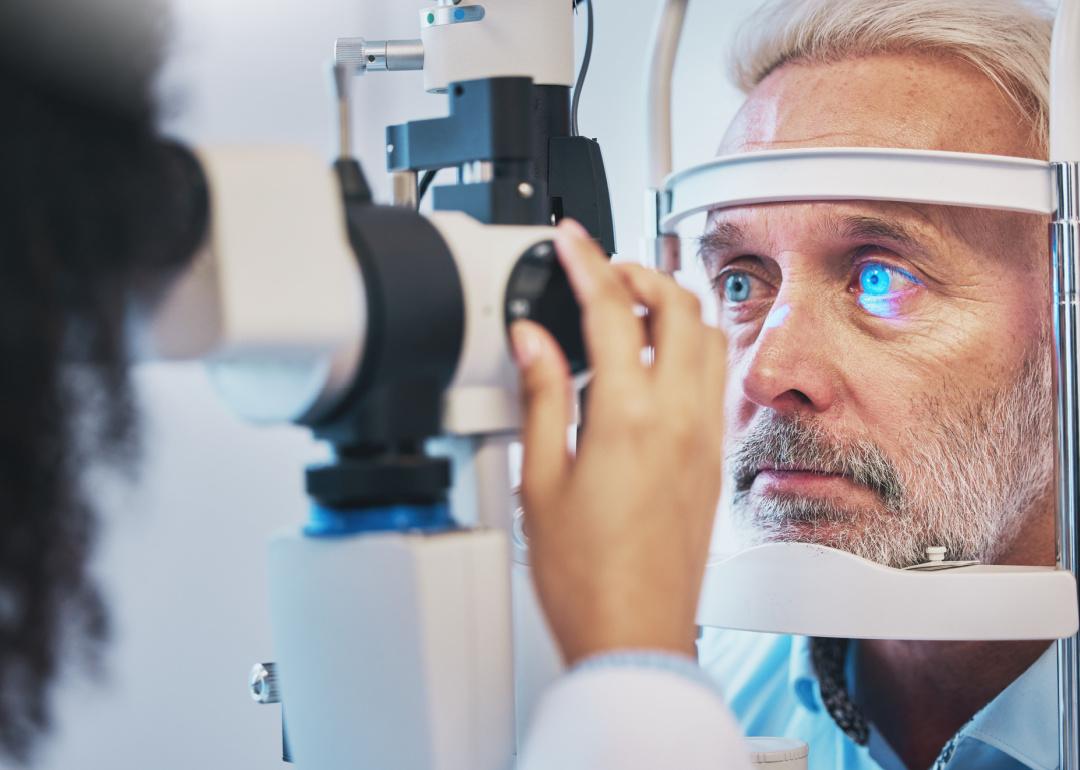[ad_1]
Using a variety of news and scientific sources, Stacker has compiled a list of 25 different aches and pains one could experience and what each means.
– Prostock-studio // Shutterstock
Andrew Jose
Nociceptors—commonly known as pain receptors—found throughout the body in bones, blood vessels, muscles, and skin, alert the body to damage and the risk of injury. Nociceptors are essentially nerve endings. The body registers a pain sensation when signals from these endings reach the brain upon detection of injury or risk of injury to the body. The skin alone has around 200 pain receptors per square centimeter (yet only a handful for detecting cold and heat).
Though “pain” and “ache” are commonly used interchangeably, they actually refer to distinct types of discomfort in the body. An ache is a feeling of hurt that is usually linked to a specific part of the body. Aches are generally not very strong and can be easily ignored, though they can linger for a sustained period of time, such as following a strenuous workout. Pain, on the other hand, is stronger and more acute than aches and is very difficult, if not impossible, to ignore. An ache, in this sense, can be thought of as a milder counterpart to pain.
Both types of hurt serve as an alarm, alerting one to underlying conditions, and as a deterrent against endangering oneself by performing activities harmful to the body.
Using a variety of news and scientific sources, Stacker compiled a list of 25 different body aches and pains one could experience and what experiencing each one of the listed aches and pains could mean.
![]()

Canva
Jaw pain
Pain in the jaw can range from stiffness in the joints connecting the skull with the lower jaw to a throbbing pain or ache following an injury. Common conditions responsible for jaw pain include temporomandibular joint disorder, arthritis, periodontal disease, and infections such as sinusitis and tetanus. A pain that starts in the chest or shoulders and reaches the jaw could be indicative of a heart attack.

kenchiro168 // Shutterstock
Testicular pain
Pain in the testicles can be caused by a wide variety of physical injuries, inflammation, sexually transmitted diseases, testicular torsion (twisting), or testicular cancer. The origin of the pain could be in the testicles themselves or from the epididymis, which is the tube and tissue behind the organs. Common causes of testicular pain include hernias, kidney stones, trauma from physical injuries, prostatitis, and orchitis.

smolaw // Shutterstock
Vaginal pain
Pain in the vagina includes simple feelings of discomfort and sensations of burning and soreness. These can be caused by cysts, infections, and other medical conditions. That said, pain in the vagina does not necessarily indicate an underlying condition—it could be caused by minor injuries during sexual intercourse, medical procedures, or childbirth. Common conditions associated with pain in the vagina, however, include yeast infection, vaginitis, vulvodynia, and cervical cancer.

Inside Creative House // Shutterstock
Back pain
There is a wide variety of back pain people can encounter during their lifetime. These range from muscle aches to sensations of burning or stabbing, making movements like bending, standing, walking, and lifting weights difficult. Often pains in the lower back and leg region are caused by sprains and strains. However, back pains can also be symptoms of other conditions such as spinal infection, fibromyalgia, arthritis, sciatica, and ankylosing spondylitis (inflammation of the joints and vertebrae).

Prostock-studio // Shutterstock
Abdominal pain
Abdominal pain includes feelings of discomfort, pain, and other hurtful sensations in the region of the body between the chest and groin. There are four primary types of abdominal pain: generalized pain, which includes pain that is felt in over half of the belly area; localized pain, which includes pain restricted to one section of the abdominal region; cramp-like pain; and colicky pain, which is severe pain that comes in waves that begin and subside suddenly.
Common conditions associated with abdominal pain include indigestion, gas, intestinal blockage, kidney stones, gallstones, pneumonia, gastroesophageal reflux disease, inflammatory bowel disease, appendicitis, cancer, blocked blood vessels, and ectopic pregnancy.

Canva
Knee pain
Pain in the knee includes pains in the skin, muscles, bones, cartilage, meniscus, tendons, ligaments, bursa, and other parts that comprise the human knee. Swelling, stiffness, redness, instability, popping and crunching noises, and being unable to extend the knee fully are signs of knee pain. Knee pain can be caused by injuries such as a torn anterior cruciate ligament, fractures, ruptured meniscus, bursitis or the bursting of the fluid sacs cushioning the knee, and patellar tendinitis. Arthritis and mechanical problems such as a loose body, dislocated kneecap, and iliotibial band syndrome can also cause knee pains.

Cast Of Thousands // Shutterstock
Calf pain
The calves refer to the area beginning at the back of the knee, opposite the shin, running down to the ankle. Pain in this part of the legs can be caused by cramps due to intensive physical activity and dehydration, muscle strain, blockages in blood vessels, and neurogenic claudication—a condition where the nerves in the area are pinched. Many common causes of pain in this part of the body are easily treatable.

Canva
Burning sensations in feet and hands
Burning sensations in the hands and feet can range from mild discomfort to unbearable severe pain. Such sensations are often a symptom of neuropathy, or nerve damage, which results in pain receptors sending false signals to the brain even though the body has not suffered an injury. Diabetes, vitamin deficiencies, alcohol abuse, autoimmune diseases, heavy metal poisoning, and erythromelalgia are common causes of these sensations.

Canva
Spinal headache
Spinal headaches are characterized by a dull, throbbing pain differing in intensity that becomes more painful when one gets up or stands. Such headaches often come with dizziness, ringing in the ears, loss of hearing, blurred vision, light sensitivity, nausea, stiffness or pain in the neck, and seizures. These headaches are often complications occurring during a spinal tap procedure where spinal fluid leaks from the puncture hole made by surgeons.

Canva
Cluster headache
Cluster headaches are characterized by pain lasting 15 minutes to as long as three hours on one side of the head, accompanied by nasal congestion, tearing in the eyes, and a drooping eyelid. These headaches usually come after a period of no pain lasting for around a month. Doctors have thus far been unable to determine the exact cause of such headaches; however, cluster headaches appear to have a connection with sudden secretions of histamine and serotonin in a facial nerve known as the trigeminal nerve.

Canva
Migraine headache
A migraine headache is a throbbing, pulsating pain in one part of the head. These headaches are often accompanied by symptoms such as nausea, vomiting, and increased sensitivity to light, noise, and odors. According to the National Institute of Neurological Disorders and Stroke, migraines occur when nerve fibers in the blood vessels of the brain that pass through the meninges are activated. Possible factors that raise the likelihood of one experiencing a migraine are strong fumes, stress, low blood sugar, skipping meals, sleep deprivation, and trauma from injuries to the head.

Prostock-studio // Shutterstock
Thunderclap headache
As the name suggests, thunderclap headaches are a rare type of severely painful headache that strikes someone with intense pain when they least expect it, just like thunder. Often, thunderclap headaches are accompanied by nausea and vomiting and are symptoms of serious conditions such as internal bleeding in or around the brain. It is important to seek medical attention when experiencing such headaches.

Bangkoker // Shutterstock
Ear pain
Pain in the ears can range from dull aches to acute pain with burning sensations. Ear pains do not necessarily mean that there are underlying conditions in the body and can be caused by changes in weather and pressure. Common causes of ear pain include arthritis in the jaw, infection, injuries due to changes in pressure, earwax buildup, holes in the eardrum, sinus infections, and infections in the teeth.

Canva
Wrist pain
The wrists are an intricate part of the body composed of four ligaments, six tendons, and eight bones. The wrists play a crucial role in performing day-to-day tasks, especially for those working at a desk on their computers. Common causes of wrist pain include arthritis, carpal tunnel syndrome, cysts, tendinitis, and Kienbock’s disease.

Prostock-studio // Shutterstock
Sinus headache
The sinuses play an important role in humidifying inhaled air and secreting mucus, which pushes dirt, dust, and other substances out of the sinuses and into the throat, where they are conveyed down to the stomach and destroyed by acids. However, when these air-filled spaces suffer from inflammation due to infection or allergies, they produce excessive mucus, causing blockages and pressure, resulting in pains such as headaches. Structural deformities, such as polyps and deviated septum, can also cause frequent sinus headaches.

Canva
Chest pain
Pain in the chest can present in many forms: sharp, dull, as a burning sensation, an ache, a stabbing sensation, or a feeling of being crushed or squeezed in the chest. The chest is home to the lungs, esophagus, muscles, ribs, and nerves, and pain in this region should not be treated lightly, as it could be a symptom of a serious condition. Pain in the chest could indicate that one has issues in these parts of the body, such as coronary artery disease, a heart attack, pneumonia, or gastrointestinal complications.

Pheelings media // Shutterstock
Ocular eye pain
Ocular eye pain is pain experienced on the eye’s surface, often characterized by itching and burning sensations caused by foreign particles, infections, or injury-related trauma. Infection from dirty contact lenses, styes, and conjunctivitis can cause ocular eye pain.

PeopleImages.com – Yuri A // Shutterstock
Orbital eye pain
Orbital eye pain refers to pain, usually severe, inside the eye. Orbital eye pain is an indicator of serious conditions and should not be ignored. Glaucoma and optic neuritis are two possible conditions underlying orbital eye pain.

fizkes // Shutterstock
Fibromyalgia
Fibromyalgia does not refer to a type of pain but a condition of its own. Scientists and doctors have not been able to isolate a specific cause for this condition, and treatment usually is centered on managing the symptoms. Fibromyalgia is characterized by pain in multiple parts of the body, muscle tenderness, sleeping issues, and fatigue.

SaiArLawKa2 // Shutterstock
Penile pain
The penis is part of the human excretory and reproductive system, conveying semen during sexual intercourse and urine during urination. Pain in the penis can occur in the organ’s base, shaft, head, or foreskin and can be accompanied by an itching, burning, or throbbing sensation. Possible causes of penile pain include Peyronie’s disease, infections in the foreskin, urinary tract infections, cancer, phimosis, and paraphimosis.

staras // Shutterstock
Kidney pain
The kidneys play a key role in purifying blood and removing drugs and impurities from the body. Kidneys are located right underneath the rib cage, flanking the spine. Pain in the kidneys is often mistaken for back pain. Kidney stones, urinary retention, kidney infection, and renal cancer are common causes of kidney pain.

Prostock-studio // Shutterstock
Tonsil pains
Tonsillitis refers to inflammation in the tonsils, a group of lymph nodes in the mouth, which help filter out germs from the body. Tonsilitis can be caused by viral or bacterial infection and is common among young children. Symptoms of tonsillitis include swallowing difficulties, pain in the ears, fever, sore throat, and headache.

AstroStar // Shutterstock
Toe pain
Toes help with shock absorption and with maintaining balance while walking and running. A common cause of pain in the toes can be exercising too much. Other causes include ingrown toenails, fractures, and bunions.

Art_Photo // Shutterstock
Voice box pain
The larynx or voice box is an organ housing the vocal cords through which the sound of an individual’s voice is produced. Inflammation in this organ, known as laryngitis, can result from overuse of the organ or infection and is often accompanied by a hoarse voice, loss of voice, dry throat, and dry cough.

Canva
Breathing pains
Because breathing is perpetual, pains during respiration can become unbearable. Pains during breathing can be due to infection and trauma from injury in the lungs or other organs in the chest. Pneumonia, costochondritis, rib fractures, and pericarditis are notable conditions associated with breathing pains.
Story editing by Brian Budzynski. Copy editing by Tim Bruns.
[ad_2]
Source link






